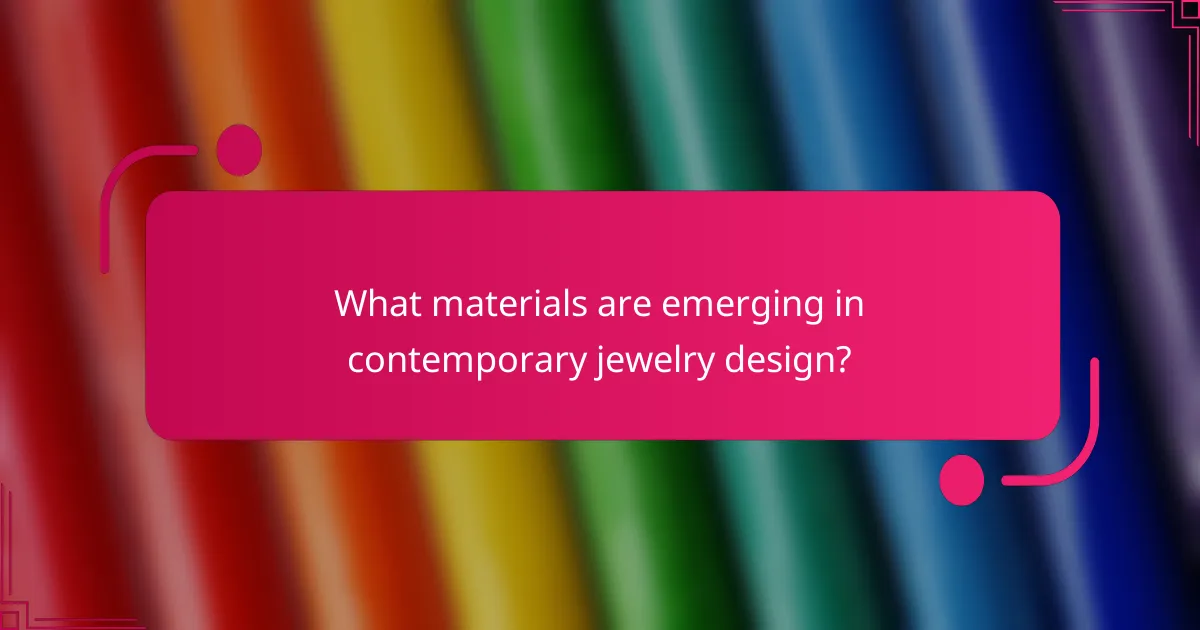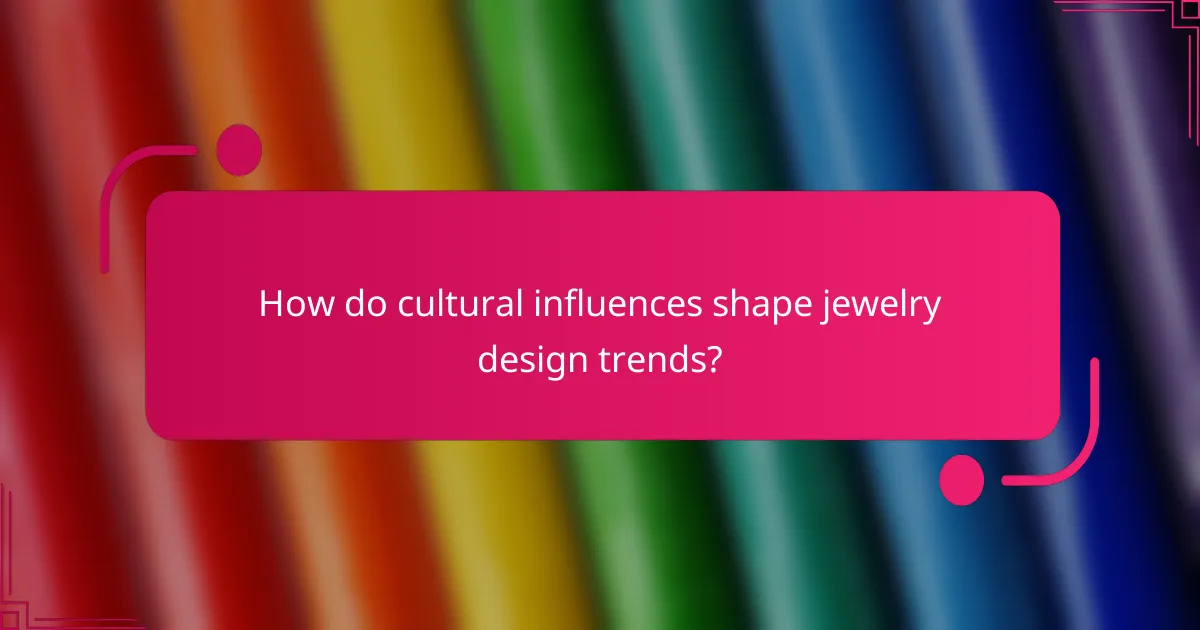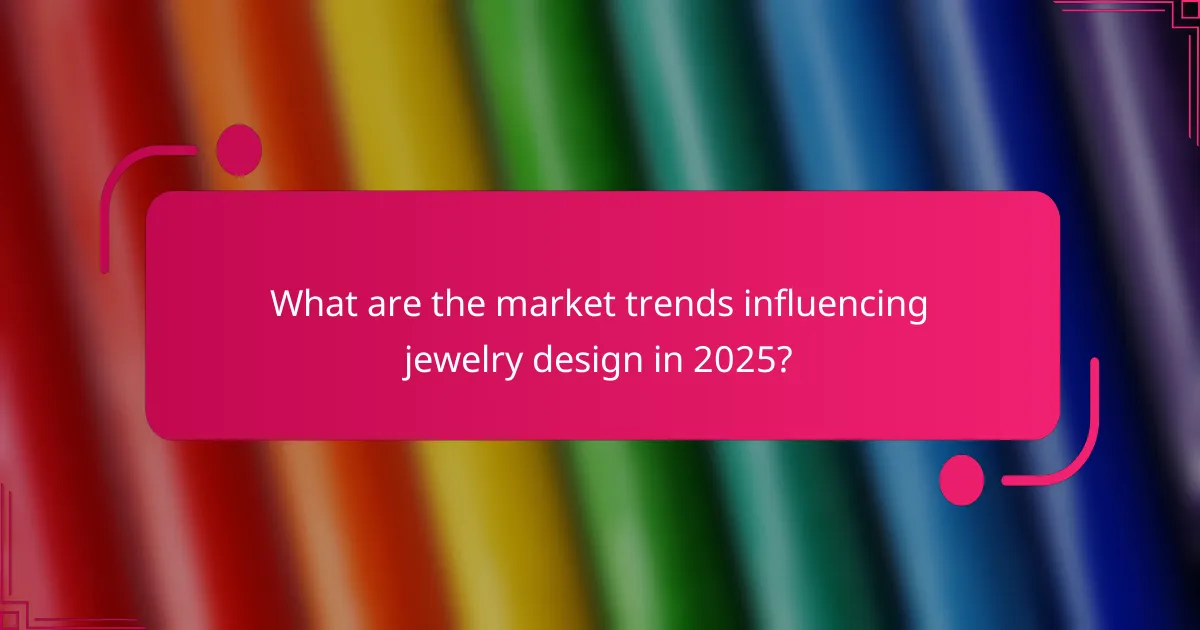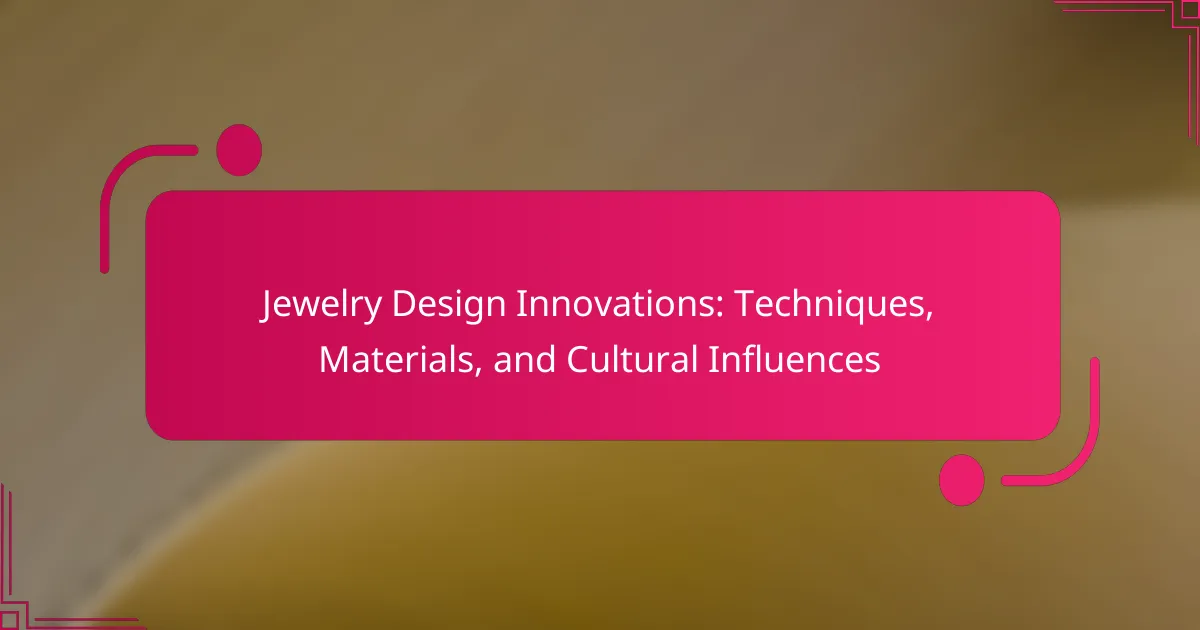Jewelry design is evolving rapidly, driven by sustainability, technology, and cultural influences. Innovations like 3D printing and lab-grown materials enhance creativity while addressing ethical concerns. Digital design tools streamline production, allowing for intricate customization. Cultural narratives inspire unique aesthetics, blending tradition with modern techniques to appeal to diverse audiences.

What are the latest techniques in jewelry design innovations?
Recent jewelry design innovations include 3D printing, sustainable materials, and digital design tools. These techniques enhance creativity and environmental responsibility in the industry.
3D printing allows for intricate designs that were previously impossible, offering customization and reducing waste. Sustainable materials, such as lab-grown diamonds and recycled metals, address ethical concerns while maintaining quality. Digital design tools enable designers to visualize and modify their creations efficiently, streamlining the production process.
Cultural influences also shape modern jewelry design, with global trends inspiring unique styles and techniques. As a result, contemporary jewelry reflects a blend of tradition and innovation, appealing to diverse audiences.
How does 3D printing transform jewelry creation?
3D printing revolutionizes jewelry creation by enabling intricate designs and personalized pieces. This technology allows designers to produce complex geometries and customize items efficiently.
The use of various materials, including metals and plastics, enhances creativity and reduces waste. As a result, artisans can explore innovative styles while maintaining sustainability.
3D printing also democratizes jewelry design, allowing independent creators to enter the market with lower initial costs. This shift fosters diversity in design, reflecting cultural influences and individual expression.
Overall, 3D printing transforms jewelry creation by merging technology with artistry, leading to unique, sustainable, and accessible designs.
Which CAD software is most popular among jewelry designers?
Rhinoceros (Rhino) is the most popular CAD software among jewelry designers. It offers advanced modeling tools tailored for intricate designs. Additionally, its compatibility with various plugins enhances functionality, making it a preferred choice for professionals. Other notable software includes MatrixGold and 3Design, which also cater specifically to the jewelry industry. Rhino’s versatility and user-friendly interface contribute to its leading position in jewelry design.
What role do traditional handcrafting techniques play in modern design?
Traditional handcrafting techniques significantly influence modern jewelry design by integrating cultural heritage and artisanal skills. These methods enhance uniqueness, allowing designers to create pieces that tell a story. For example, techniques like hand engraving and metalworking offer a tactile quality that mass production cannot replicate. As a result, contemporary designers often blend these traditional skills with innovative materials, creating a fusion of old and new. This approach not only preserves cultural identities but also appeals to consumers seeking authenticity in their jewelry.

What materials are emerging in contemporary jewelry design?
Emerging materials in contemporary jewelry design include sustainable options like lab-grown diamonds, recycled metals, and innovative polymers. These materials reflect a shift towards eco-conscious practices and unique aesthetics. Additionally, 3D printing technology allows for intricate designs that were previously unattainable. The use of alternative materials like wood and resin adds a distinctive touch, appealing to diverse consumer preferences.
How do sustainable materials influence design choices?
Sustainable materials significantly influence jewelry design choices by promoting eco-friendly practices and innovative aesthetics. Designers increasingly use recycled metals, ethically sourced gemstones, and biodegradable materials to reduce environmental impact. These choices not only enhance the appeal of jewelry but also align with consumer values focused on sustainability. As a result, brands that prioritize these materials often attract environmentally conscious customers, creating a unique market position.
Which innovative metals are gaining popularity?
Innovative metals like titanium, stainless steel, and recycled metals are gaining popularity in jewelry design. These materials offer unique attributes such as durability, lightweight properties, and eco-friendliness, appealing to modern consumers. Titanium is known for its strength and hypoallergenic qualities, while stainless steel provides a sleek, contemporary look. Recycled metals promote sustainability, aligning with cultural influences emphasizing environmental responsibility.
What are the benefits of using synthetic gemstones?
Synthetic gemstones offer numerous benefits in jewelry design, including affordability, durability, and ethical sourcing. They provide vibrant colors and clarity, often exceeding natural stones in these aspects. Additionally, synthetic gems can be produced in various shapes and sizes, allowing for innovative designs. Their consistent quality ensures that designers can create pieces with predictable attributes, enhancing overall craftsmanship.

How do cultural influences shape jewelry design trends?
Cultural influences significantly shape jewelry design trends through symbolism, materials, and craftsmanship. Different cultures inspire unique aesthetics, reflecting their values and traditions. For instance, indigenous designs often incorporate local materials, such as turquoise or silver, showcasing a connection to nature. Additionally, cultural events and historical narratives frequently inspire contemporary jewelry pieces, leading to innovative techniques that blend traditional craftsmanship with modern design. As a result, jewelry becomes a medium for cultural expression, allowing artisans to convey stories and heritage through their creations.
What are the key cultural motifs in jewelry from different regions?
Jewelry from different regions features unique cultural motifs that reflect local traditions and values. For instance, Native American jewelry often incorporates symbols of nature, representing harmony and spirituality. In contrast, Indian jewelry showcases intricate designs influenced by religious beliefs and social status. African jewelry frequently uses vibrant colors and patterns to convey community identity and heritage. Asian jewelry, particularly from China, emphasizes auspicious symbols like dragons and phoenixes, symbolizing power and prosperity. These motifs not only enhance aesthetic appeal but also serve as storytelling elements that connect wearers to their cultural roots.
How do historical events impact contemporary jewelry styles?
Historical events significantly influence contemporary jewelry styles by shaping design aesthetics, material choices, and cultural symbolism. For example, the Art Deco movement, emerging after World War I, introduced geometric shapes and bold colors, which continue to inspire modern pieces.
Cultural shifts, such as the feminist movement, have led to jewelry that emphasizes empowerment and individuality. Designers now incorporate sustainable materials reflecting environmental awareness, a response to global ecological concerns.
Additionally, historical craftsmanship techniques, like filigree or cloisonné, are revived in modern jewelry, blending tradition with innovation. These elements create a rich tapestry that connects past narratives with current trends, ensuring that jewelry remains a dynamic form of artistic expression.
Which cultural festivals inspire unique jewelry creations?
Cultural festivals inspire unique jewelry creations through vibrant themes and traditional craftsmanship. Events like Diwali in India showcase intricate designs using gold and gemstones, while the Day of the Dead in Mexico features colorful, symbolic pieces crafted from silver and enamel. Additionally, the Venice Carnival leads to elaborate masks adorned with handmade jewelry, emphasizing local artistry. These festivals highlight the fusion of cultural heritage and innovative techniques in jewelry design.

What are the market trends influencing jewelry design in 2025?
Market trends influencing jewelry design in 2025 include sustainability, technological integration, and cultural diversity. Sustainability drives the use of recycled materials and ethical sourcing. Technological advancements enable 3D printing and augmented reality in design processes. Cultural influences reflect global aesthetics, blending traditional craftsmanship with modern styles. These trends reshape consumer preferences, emphasizing unique, eco-friendly, and innovative designs.
How does consumer demand affect material selection?
Consumer demand significantly influences material selection in jewelry design. Designers prioritize materials that resonate with current trends, sustainability, and consumer preferences. For instance, the rise in demand for eco-friendly materials has led to increased use of recycled metals and lab-grown gemstones. Additionally, cultural influences shape material choices, as consumers seek pieces that reflect their values and heritage. As a result, understanding consumer demand is essential for innovative and relevant jewelry design.
What role does social media play in shaping design trends?
Social media significantly influences jewelry design trends by facilitating real-time sharing and collaboration. Designers showcase their work, gaining immediate feedback and inspiration from global audiences. Platforms like Instagram and Pinterest highlight emerging styles, materials, and cultural influences, making trends more accessible. User-generated content often drives innovation, as consumers share their preferences and unique designs, leading to a dynamic exchange between creators and buyers. This interaction fosters a vibrant community that continuously shapes the jewelry landscape.
Which demographics are driving innovation in jewelry design?
Younger generations, particularly millennials and Gen Z, are driving innovation in jewelry design. They prioritize sustainability, personalization, and unique materials. This demographic influences trends through social media and a desire for meaningful, culturally inspired pieces. As a result, brands are adapting to these preferences by exploring eco-friendly materials and innovative techniques.

What are the challenges faced by modern jewelry designers?
Modern jewelry designers face several challenges that impact their creativity and business. High competition and the need for unique designs can stifle innovation. Additionally, sourcing sustainable materials is increasingly important but often difficult. Economic fluctuations affect consumer spending, making it harder to predict market trends. Furthermore, adapting to technology, such as 3D printing, requires continuous learning and investment. Finally, cultural influences can complicate design choices, as designers must balance tradition with contemporary tastes.
How do designers balance creativity with marketability?
Designers balance creativity with marketability by integrating innovative techniques and materials that resonate with cultural influences. They focus on unique designs that appeal to consumer preferences while ensuring functionality and aesthetic appeal. By researching market trends, designers can align their creative visions with what is commercially viable. Collaborating with artisans and incorporating sustainable practices also enhances marketability, attracting eco-conscious consumers.
What are the common pitfalls in adopting new technologies?
Common pitfalls in adopting new technologies include resistance to change, lack of training, and insufficient integration with existing systems. Organizations often underestimate the time needed for implementation and fail to align new technologies with business goals. Additionally, neglecting user feedback can lead to poor adoption rates. These issues can hinder the potential benefits of innovations in jewelry design, such as advanced materials and techniques.
How can designers overcome the sustainability challenge?
Designers can overcome the sustainability challenge by integrating eco-friendly materials and innovative techniques into their jewelry designs. Utilizing recycled metals and ethically sourced gemstones reduces environmental impact. Biodegradable materials, such as plant-based resins, offer unique aesthetics while promoting sustainability. Collaborating with artisans from diverse cultures enriches designs and emphasizes the importance of traditional craftsmanship. Embracing these strategies fosters a more sustainable jewelry industry.
What are best practices for integrating cultural elements in design?
Integrating cultural elements in jewelry design enhances authenticity and connection. Best practices include researching cultural significance, collaborating with cultural experts, and using traditional techniques. Additionally, ensure respectful representation of symbols and motifs, prioritizing community engagement throughout the design process. This approach fosters innovation while honoring heritage.
How can emerging designers establish their unique voice in a saturated market?
Emerging designers can establish their unique voice by embracing innovation in techniques, materials, and cultural influences. They should explore unconventional materials, such as sustainable options, to differentiate their designs. Incorporating diverse cultural elements can provide authenticity and depth, resonating with specific audiences. Networking within artistic communities fosters collaboration and exposure, enhancing visibility. Lastly, leveraging digital platforms for storytelling allows designers to share their creative process, further solidifying their identity in a crowded market.
What tips can enhance innovation in jewelry design?
To enhance innovation in jewelry design, focus on experimentation with techniques, materials, and cultural influences. Embrace new technologies like 3D printing for unique forms and intricate details. Collaborate with artists from diverse backgrounds to incorporate fresh perspectives. Explore sustainable materials to attract eco-conscious consumers. Engage in trend analysis to stay ahead in design aesthetics.
